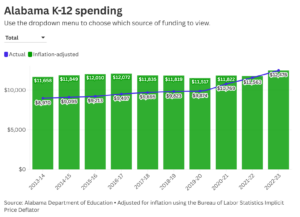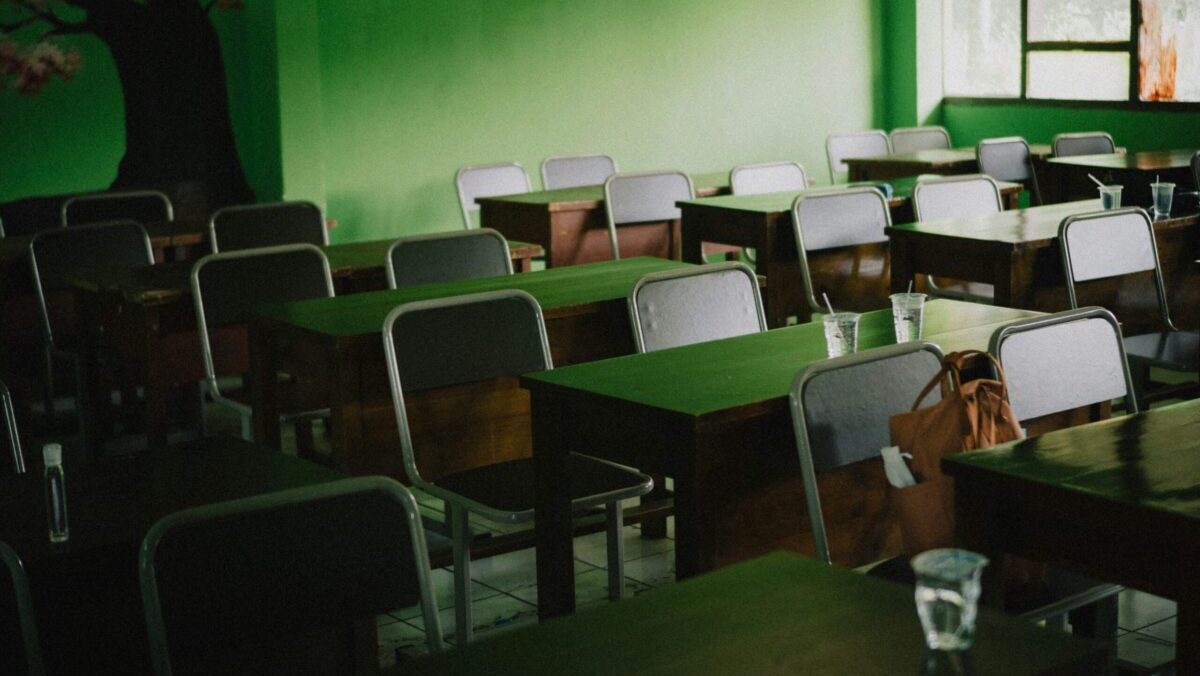Spending on Alabama’s K-12 students went up across the board, according to spending data released by the Alabama Department of Education.
The average amount spent during the 2022–23 school year, the most recent year publicly available, rose from $11,563 to $12,476 per K–12 student. That includes funding from state, federal and local sources. Capital costs are not included in the per student costs.
When adjusted for inflation, the increase is still there, but historically Alabama’s state portion of student funding has barely risen above funding levels from a decade ago.
The proportion of overall spending coming from federal sources rose at a faster pace than state or local sources for the third year in a row. That faster pace was due to an infusion of more than $3 billion in federal pandemic relief between 2020 and 2023. That money is now gone; the last deadline for spending federal COVID relief was Sept. 30.
Pandemic relief funding was a difference-maker in schools, according to Council for Leaders in Alabama Schools’ Executive Director Vic Wilson. “One of the things the federal money did was help us utilize interventionists,” he said.
Interventionists worked one-on-one or in small groups with students who were academically behind, and those efforts showed up in results. “We’ve made wonderful gains across the board,” Wilson added.
Test scores and report cards
Test scores from spring 2024 were up in many places, and report cards, released last week, show improvement, too, in most schools across the state.
School officials knew that the extra federal funding was temporary and would end this year, but it helped address unfinished learning during the pandemic.
Now that the money is gone, Wilson said, school officials have to figure out what to do next.
“You’ve got to either, one, figure out how you can replace it, or two, figure how you’re going to do without it, right?” he said. “And that’s where we find ourselves for now.”
Overall, average federal per student funding rose dramatically during the pandemic, from $1,400 before COVID relief funds kicked in to $2,450 during the 2022-23 school year. Inflation-adjusted numbers show a sharp increase, too.
Considering inflation
Year over year, the increase appears to be substantial, but inflation has cut into costs for schools just as it has for families.
State per student funding rose from $6,800 in the 2019-20 school year to $7,732 in the latest figures. When adjusted for inflation, though, funding has actually declined — from $7,950 in 2019-20 to $7,732 in 2022–23.
Spending at the school level ranged widely, from $1,400 per student at a virtual school in Chickasaw to $283,000 for each student at the Etowah County Special Education Learning Center.

Here’s a look at the average per student funding across all Alabama K-12 schools for the past decade. The line represents the actual amount spent, and the green bar represents that funding adjusted for inflation. Use the dropdown menu to choose whether to see the total spending or the amount provided through state, federal or local funding.
State funding, which includes the formula-based and line-item funding outside of the formula, has barely kept pace with inflation, while local funding has actually lost ground when adjusted for inflation.
State lawmakers are currently considering whether to modernize the state’s formula for funding schools. Created in 1995, it allocates funding on costs to fund the resources — teachers, textbooks, principals, etc. — schools are projected to need to educate the average student, basically funding all children as if they cost the same to educate.
The new formula, called a student-weighted formula, would consider the additional educational costs when students face challenges like poverty or disabilities and provides additional funding to meet those challenges.
To read full story, click here.
EDITOR’S NOTE — This story was written by Trisha Powell Crain and originally published by Alabama Daily News. It is reprinted with permission.






Share with others: